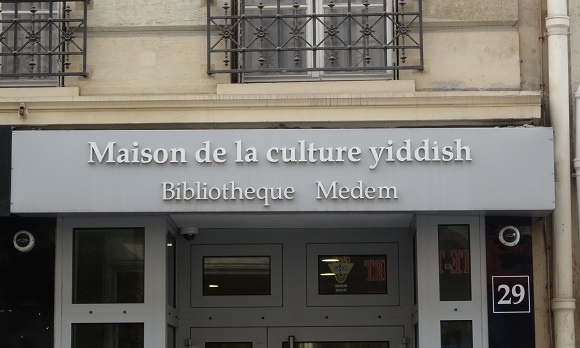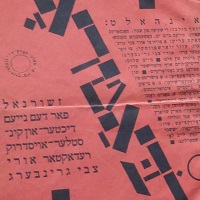
Yiddish is a live and well in Paris at the Medem Library, the largest Yiddish cultural center in Europe.
Paris – In a year during which the French calendar is highlighted with festivities and commemorations surrounding the 70th anniversary of the Liberation of France, 1944—from D-Day (June 6) to the Liberation of Paris (Aug. 25) to the Liberation of Strasbourg (Nov. 23)—the reopening of the Medem Yiddish Library 70 years ago this week, on October 14, 1944, was noted by few.
The date nevertheless resonates as a marker of the return of Jews from hiding in France and their first steps toward reclaiming an identity and a language that Nazism and its allies, including in France, sought to wipe out.
Though relatively small and discreet compared to the world’s major Yiddish centers in New York and in Israel, the Medem Library’s 30,000 volumes (of which 20,000 are in Yiddish) and 7500 recordings, along with the classes, workshops and events of the Paris Yiddish Center (together with the library they form a single entity) make this the largest Yiddish cultural center in Europe.
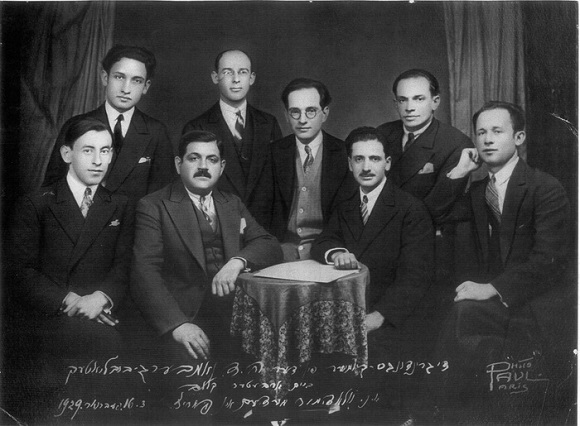
In 1939, at the outset of the Second World War, it was common to hear Yiddish in certain quarters of Paris, particularly in the 3rd, 4th, 10th and 11th arrondissements. Yiddish, the language that most unified European Jewry before the Holocaust, had been spoken among some families and communities in Paris since the liberating effect of the French Revolution began drawing Jews to the French capital. Its presence was increasingly seen and heard in the northeast quadrant of Paris after 1880s, when greater waves of Jewish immigration began arriving from the east, waves that would also reach the shores of North America.
Over coffee and chocolate rugelach with members of the administration and the staff in the center’s little café in Paris’s 10th arrondissement, Gilles Rozier, author, translator from Yiddish and the Medem Library’s director from 1994 until June 2014, outlined the history of the library and cultural center.
At the time of its founding in 1929, during the golden age of Yiddish artistic and literary creation and publication, the Medem Library was just one of a number of Yiddish libraries and centers in Paris. Each Jewish political party or religious movement, Rozier explained, had its own library which also served as a form of social and cultural center, a gathering place where there was often a soup kitchen for those in need. Neither Zionist nor religious, the Medem was created as the library of the Bund movement, a secular Jewish socialist movement that had developed in the Russian Empire in the late 19th and early 20th centuries and spread out from there, eventually brought to Paris by immigrants fleeing pogroms and unrest in Eastern Europe. The library was named for Vladamir Medem, one Bundism’s major theorists.
Though now officially apolitical, the Medem Library and Maison de la Culture Yiddish (or Paris Yiddish Center as it’s officially called in English) as an institution remains distinctly secular. It’s even open on Saturday, though closed on Friday.
Foreign Jews in France, already targets of anti-Semitism and anti-immigration sentiment during the economic downturn of the 1930s, were increasingly treated, legally, as outcasts once the German Occupation began in 1940, at which time the rights of French Jews were also progressively diminished. Two years later, both foreign and French Jews were being deported to concentration camps. Authorities closed the Medem Library in 1943 but not before many of its books had been hidden in the basement of the building that then housed the Medem Library at 110 rue Vieille du Temple in the Marais. About 76,000 of the 270-300,000 Jews living in France before the war were killed between 1940 and 1945.
Following the Liberation of Paris from German Occupation and the removal of the Vichy Government, the Medem Library reopened on October 14, 1944. It was a small but significant step in a return to normalcy for Jews in the capital.
The number of Yiddish speakers in Paris after the war nevertheless continued to wane. Pogroms in the Soviet Union, particularly in 1956 and 1968, saw a small influx of Jewish immigrants who brought along their personal libraries, including books in Yiddish, eventually resulting in an expansion of the Medem and other libraries then still in existence. Yet the number of Yiddish-speakers was in steep decline as younger generations no long learned the language of their parents or grandparents. During the same period, the arrival of Sephardic Jews from territories formerly controlled by France in North Africa (Morocco, Algeria, Tunisia) meant that Yiddish, historically spoken by the Ashkenazi, was no longer the primary shared language of new Jewish arrivals in continental France.
That might have spelled the end of the Medem as a gathering place, as it did for other Yiddish libraries, but the 1970s brought with them an awareness of and desire to maintain contact with one’s roots. What was true for Breton and Basque, the languages and cultures of Brittany and Basque Country, respectively, was also true of Yiddish. Roots for Jews may also mean an attachment to prayer/the synagogue and/or to Zionism, but in the case of the Medem Library, one of whose pillars remained secularism, it was the language of pre-war European Jewry that brought people together. By the 1980s, with Yiddish classes in full swing, the Medem Library was becoming more a research library than a popular library.
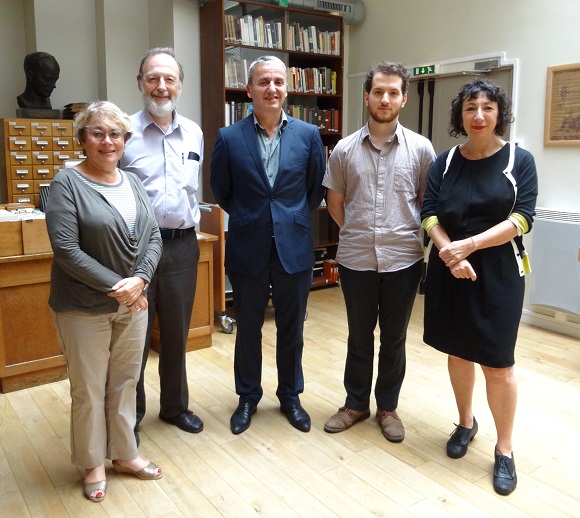
By the 1990s, as other Yiddish libraries and institutions closed and publications ceased, the Medem was receiving some of their collections along with collections of citizens no longer capable of reading their parents’ or grandparents’ books.
Moved to its current location, it was less the books themselves that kept the Medem Library alive than the emphasis on learning Yiddish and the enjoyment and understanding of Yiddish culture (particularly klezmer, theater, song and cooking)—in short, on transmitting Yiddish heritage. Since 2002 the center has been called Maison de la Culture Yiddish – Bibliothèque Medem.
Asked if the center was associated with the Association for the Promotion of Foreign Languages in France, Fanny Barbaray, the center’s president, said that Yiddish couldn’t be considered a foreign language but was rather a “language of France” more comparable to Breton and Basque.
In the 85 years since its creation in 1929, the Medem Library has only had four directors: Kiva Vaisbrot, one of its founders, who assumed the position until 1979, Yitskhok Niborski, director from 1979 to 1994, Rozier, director from 1994 to June of this year, and Tal Hever-Chybowski, director since September.
The House of Yiddish Culture and Medem Library occupy 7000 square feet of the ground floor and basement of a building in the 10th arrondissement (near a nice little indoor food market). Only the ground floor is open to the public. Most of the books, recordings and documents are stored the basement, available for retrieval by the Medem’s librarian, Natalia Krynicka. A hallway exhibition space, three classrooms and a small café are open to the public, as are the reading room with membership to the library, the classroom for those registered and an 80-seat room where cultural activities and events are held.
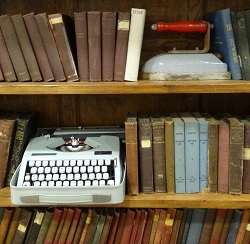 Along with Yiddish classes for all levels, the center holds klezmer, dance, choral, theater and cooking workshops and has a choral group as well as programing for children. Concerts, readings, encounters with authors and film projections also take place. While Jews make up the vast majority of those taking Yiddish classes, Barbaray noted that there are a significant number of non-Jews in the klezmer workshops.
Along with Yiddish classes for all levels, the center holds klezmer, dance, choral, theater and cooking workshops and has a choral group as well as programing for children. Concerts, readings, encounters with authors and film projections also take place. While Jews make up the vast majority of those taking Yiddish classes, Barbaray noted that there are a significant number of non-Jews in the klezmer workshops.
While visitors may encounter Yiddish speakers at any time at the center, its little Tshaynik Café especially becomes a Yiddish-speaking coffee klatch on Thursday from 2:30 to 4:30pm.
In addition to income derived though classes, workshops and membership, the center receives subsidies from the Paris region, DRAC Ile-de-France (a regional department of cultural affairs), the City of Paris, the Foundation for the Memory of the Shoah, the National Book Center, the Rothschild Foundation, the Rachel Ajzen and Léon Iagolnitzer Foundation, the L.A. Pincus Fund for Jewish Education in the Diaspora and the Unified Jewish Social Fund. The New York-based American Friends of the Medem Library also supports the center’s activities.
© 2014, Gary Lee Kraut
Maison de la culture Yiddish – Bibilothèque Medem, 29 rue du Château-d’Eau, 10 arrondissement. www.yiddishweb.com. Tel. 01 47 00 14 00. Contact: mcy@yiddishweb.com. Metro République, Jacques-Bonsergent, Château-d’Eau.
Open Mon., Tues., Thurs. 1:30-6:30pm, Wed. and Sat. 2-5pm. Closed Friday, Sunday, French holidays and Yom Kippur.
For other articles about Jewish Paris on France Revisited see the March 2014 issue.


